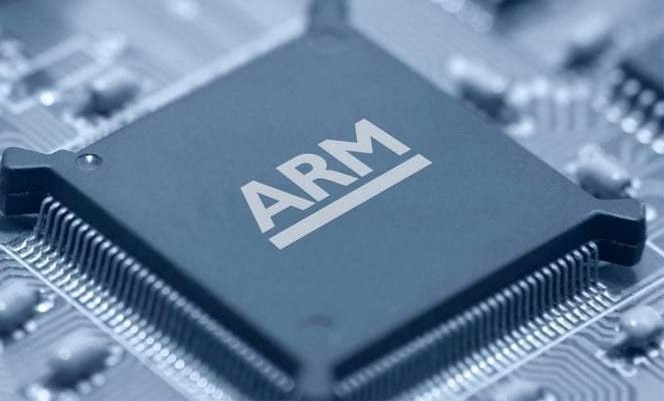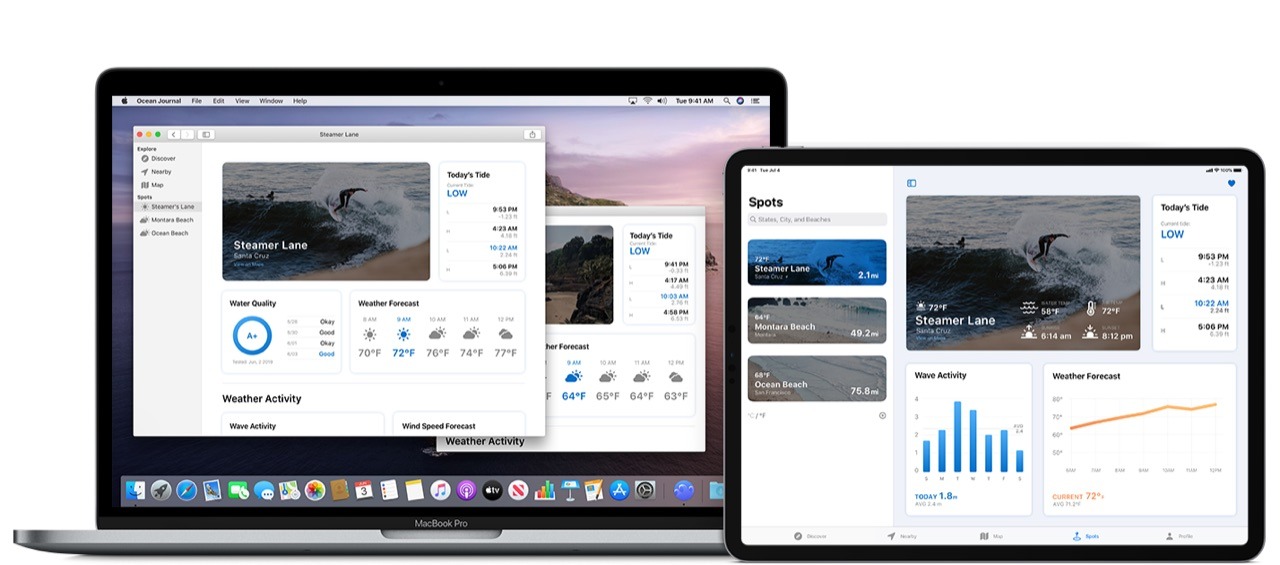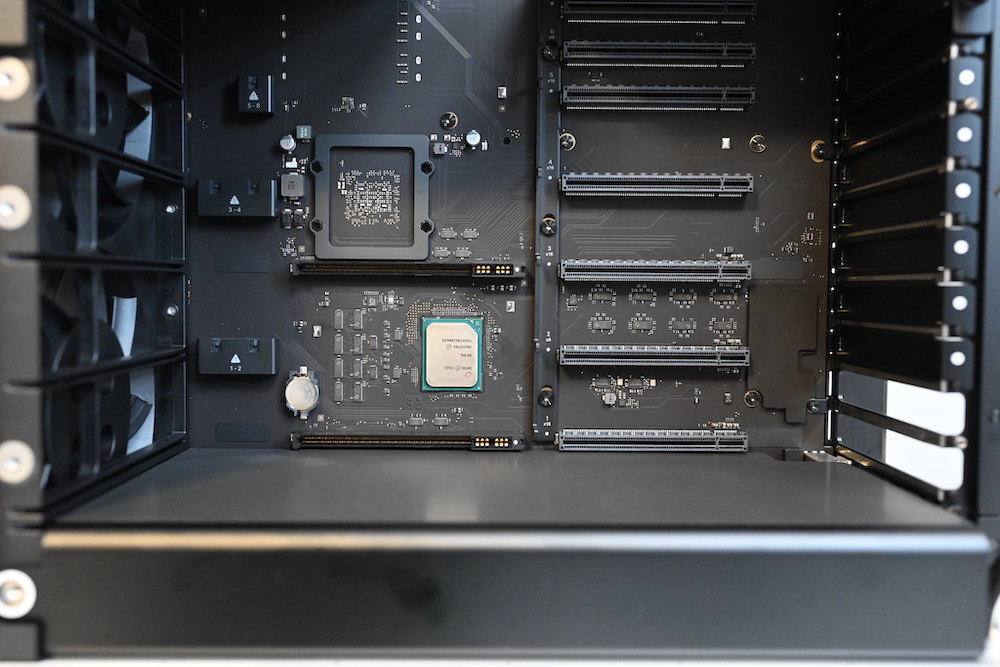Apple's transition to Macs with proprietary ARM chips may soon be officially acknowledged, but there have been clear and definite signs of the switch for years.
A recent report indicated that Apple could announce the impending change at its Worldwide Developers Conference on June 22, with the first of the ARM-based Macs due to potentially debut in 2021.
That may come as a surprise to some casual Apple fans. For astute watchers of the company's moves, the signs of another major architecture transition have long been written on the wall.
Laying the groundwork for ARM Macs
 Apple is already an ARM chipmaking expert, with A-series chips powering the company's iPhones, iPads and Apple TVs.
Apple is already an ARM chipmaking expert, with A-series chips powering the company's iPhones, iPads and Apple TVs.Some of Apple's "tells" of a major architecture switch, such as Project Catalyst or the dropping of 32-bit support, have been more obviously apparent than others.
When you look at the history of the Mac from about 2014 to 2020, it becomes clear that Apple has been taking subtle but sure steps creating a more ARM-friendly Mac ecosystem, and paving the way for an ARM Mac in general.
Here's how Apple has laid the groundwork for ARM Macs for longer than a decade.
Xcode
Rumors of an ARM Mac are fairly recent, at least compared to the history of the Mac itself. But way back in 2003, Apple made what is really the first publicly visible step toward an ARM Mac: releasing Xcode.
The Mac-based integrated development environment changed completely overhauled how developers created apps and programs for Apple platforms and products. Before the release of the integrated development environment, there was a slew of different tools for development and programming.
While Apple may not have specifically had an ARM Mac in mind when it released Xcode, the unified IDE was needed for the iPhone, and was still the first initial step toward such a device. Without a centralized development environment for macOS, the current transition — and the previous shift to Intel — just wouldn't be possible.
Xcode is also obviously built for the x86 architecture, but there are some tentative signs that Apple may bring the IDE to ARM-based chips by way of an iPad app.
OpenGL and Metal
Apple has been tightening up its signature blend of hardware, software and OS integration. The introduction of Metal on iOS in 2014 — and ultimate deprecation of OpenGL in 2018 — introduced a new layer of independence for Apple developers.
Compared to the previous graphics technology, Apple says Metal allows a CPU and GPU to "work together more effectively." By using Metal, both macOS and iOS developers could code to this specific API and allow their apps to function regardless of what GPU is present. For Apple-designed hardware like ARM chips, it's going to be integral, especially if Apple GPUs are on the distant horizon as well.
That switch from the previous OpenGL technology began a broader Apple push toward interoperability for apps and developer platforms. Along with other developments on this list, the introduction of Metal played a role in streamlining and simplifying the larger Apple ecosystem.
Although not a heralding of ARM-based Mac devices, some in the Apple development community suggest that deprecated technologies like OpenGL are going to be completely removed during the architecture switch. Based on the fact that OpenGL dependencies are already integrated using Metal, it looks like Apple has been planning for this since the technology was deprecated.
Swift
Apple's open-source Swift programming language came the exact same year, and further added opportunities for Apple — and Apple developers — to bring its disparate products together.
The initial goal of Swift was to create a language that was fast, intuitive and safer to use than what was available at the time. Importantly, it was also developed from the ground up with Apple's own products in mind. As mentioned earlier, Swift is part of a larger strategy of optimizing apps and code for different devices on iOS, and eventually, iPadOS. There's no doubt Apple will apply the lessons it learned from those platforms to ARM Macs.
Some Swift-based toolkits, like SwiftUI, could also play a larger role in the transition to ARM-based Macs. SwiftUI is an easy way for app developers to build user interfaces for products across Apple's lineup
More than that, there's the looming possibility of Apple dropping support for apps not written in Swift entirely, though developers like Gus Mueller suggest that it won't happen at first. If or whether it does, it'll be because Apple believes that having a single coding language for apps across iOS, macOS and Apple's other platforms is going to make optimization and performance better across the board.
System Integrity Protection
In 2015, Apple also introduced a new system feature called System Integrity Protection (SIP) to the kernel of OS X El Capitan. At the time, some theorized that it could be an initial effort for Apple to bring macOS security policies closer to those of iOS.
While System Integrity Protection did bolster security, it did do away with some of the UNIX-like system functions that macOS had for years. And by doing so, it took macOS a step toward its other operating systems — which are, importantly, already designed for ARM.
That's important because many of the significant security flaws we've seen over the past few years have been chip-level vulnerabilities in Intel's silicon. There's a high possibility that Apple will market the switch to ARM as a security upgrade, along with the many other benefits.
Apple T-series chips and Secure Boot
Long before serious talk about Apple ditching Intel for ARM, the Cupertino tech giant put ARM-based silicon into its Macs. Apple's introduction to ARM in the Mac was the T1 coprocessor chip in the 2016 MacBook Pro with Touch Bar.
In addition to powering the touchscreen OLED Touch Bar, the T1 also enabled the Touch ID sensor and drove the System Management Controller. Based on a similar core to ARM chips like the Apple Watch's S1, the T1 allows the Touch Bar to operate relatively independently of the actual system.
A year later, in 2017, Apple debuted the second generation of its T-series chips in the iMac Pro. Like A-series chips, the T2 enabled a suite of security functions for macOS, including a secure enclave and on-the-fly encryption. It also enabled always-on "Hey Siri," acts as a "gatekeeper" for a Mac's microphone and FaceTime camera, and could speed up certain video-based encoding workflows.
The T2 chip is a significant win for Apple platform security, as well as other associated image processing features.
From our vantage point, it also appears as a sort of "test run" for integrating ARM technology in X86 Macs. The T-series chips are purpose-built, customized chips specifically designed for Macs. With a switch to ARM-based CPUs, there are opportunities for even further integration, especially since Apple could ditch the T2 chip and bake its features directly into an ARM system-on-chip (SoC).
Death of 32-bit apps
One of the more major changes that paved the way for ARM Macs was the death of 32-bit apps. In macOS Catalina, officially dropped support for 32-bit apps.
That capped out a transition nearly a decade in the making with the release of 64-bit OS X Snow Leopard in 2009. It's especially important because it spelled the end of all the legacy 32-bit code that Macs have been running for years.
Without all of that legacy code, a Mac could, in theory, optimized to run on 64-bit ARM processors. For a transition to ARM-based Macs, that's going to be an important point for making them perform at their best.
For context, the A-series chips in iPhones and iPads are 64-bit and ARM-based. Similarly, Apple technologies like Metal only work on 64-bit architecture. In other words, the implementation of 64-bit technology implemented across Apple's lineup cleans up the company's stable of operating systems for further tinkering and new features.
Catalyst
Then there was Catalyst, one of the more apparent signs of integrating ARM support into the macOS ecosystem. Introduced at WWDC 2019, Catalyst is essentially a system designed to allow developers to more easily port iOS and iPadOS apps to the Mac. It didn't automatically spell the end of macOS-specific apps or Mac as a separate operating system, but it did lay a foundation for apps that could be optimized for an ARM environment.
While initial reactions to Catalyst were mixed, the platform did introduce features that significantly lower the barrier to entry for iOS and Mac app integration by allowing developers to effortlessly compile code for the latter platform. Effortlessly as in ticking a box in Xcode.
Apple could undoubtedly take the lessons it learned on iOS and apply them to macOS. The iOS App Store, for example, has long allowed consumers to download apps regardless of what specific code was needed to run on a specific device. But, more importantly, Catalyst makes it easy for developers to create apps that can work on both ARM and x86 architecture.
That's something that could smooth the transition for developers and consumers alike, since it'll make porting apps to an ARM-optimized version of macOS as easy as porting one from iPad to Mac. This will save developers time and hassle, particularly since the overall transition to ARM-based Macs isn't going to be a short one.
Apple isn't going to drop non-Catalyst apps out of the gate. But having Catalyst as an option for developers to create ARM-friendly content is going to make the transition a bit easier to handle.
The actual start of the "transition" to ARM Macs
 Catalyst, by allowing apps easier interoperability between ARM and x86 architecture, could make the transition easier on developers.
Catalyst, by allowing apps easier interoperability between ARM and x86 architecture, could make the transition easier on developers.The 2018 iPad Pro really clarified something about how Apple views its computing products. As the company noted at its iPad keynote that year, the iPad Pro overhaul was speedier than up to 92% of competing laptops of that time.
That didn't necessarily pertain to macOS in any way, but it made it clear that Apple's A-series chipsets were built for power. While Apple maintained that it won't merge Mac and iPad, it said nothing about making the former ecosystem more like the latter.
For eagle-eyed technologists and enthusiasts, it also hinted at the potential of Apple's first-party ARM silicon.
Consider the fact that A-series chips can outperform Intel ones in many single-core benchmarks. Those A-series chips are installed on devices without thermal cooling — one barrier to workstation-like performance from ARM chips.
A switch to ARM would be the third major architecture transition in Apple's lifetime, after moving from Motorola 68000 to PowerPC, and from PowerPC to Intel x86 in 2005. Just like those past architecture transitions, Apple has a clear goal and path in mind for the switch to ARM. It's going to make Mac devices better, whether through enhanced performance or better battery life.
Amid persistent rumors of an impending ARM-based announcement, Apple will likely make the public aware of what it's been doing behind the scenes for years.
What Apple still needs to do
 Apple may give developers a first taste of ARM with "development tool kits," which were desktop Intel machines.
Apple may give developers a first taste of ARM with "development tool kits," which were desktop Intel machines.The transition to ARM will be as seamless as possible, but it won't be without pain for some. While Apple has made a series of preparations, it's still going to be a mammoth task for both the company, its independent developers, and its customers.
Apple took a bit less than two years to move all of its Macs over to Intel-based chips. It took until August 2009 for OS X Snow Leopard to drop support for PowerPC architecture. Previously released PowerPC-based hardware was officially declared "obsolete" in 2013 — seven years after Apple discontinued them.
It's undoubtedly going to be a bumpy road for some, but Apple's previous chip architecture transitions could hint at what's coming.
Consider Apple's Development Transition Kits, which were $999 computers based on Intel hardware "rented" out to developers. There's a good chance that, for a switch as massive as Intel-to-ARM, Apple is going to do something similar. So developers with the means will be able to get their apps ARM-compatible well before consumers get their hands on the hardware.
Apple apparently believes this shift to be important, and not just because of Intel's recent hiccups. With much more minute control over the entire hardware and software stack of its devices, costs will be reduced and potential integration and optimization could be supercharged.
The switch to ARM could also further bolster Apple's status as a chipmaking superpower. Later, when the dust settles, consumers will be getting a lot more, too.
Apple's Mac transition to ARM has been years in the making. While it may be too early to tell how it pans out, it looks likely that it'll be worth the growing pains for everyone involved.
 Mike Peterson
Mike Peterson




-xl-m.jpg)


-m.jpg)






 William Gallagher
William Gallagher
 Malcolm Owen
Malcolm Owen

 Mike Wuerthele
Mike Wuerthele


 Thomas Sibilly
Thomas Sibilly
 Wesley Hilliard
Wesley Hilliard








21 Comments
The problem is that Macs are used extensively in STEM, including data science and statistics. These disciplines depend almost entirely on open source software that runs on UNIX/Linux. Further, increasingly applications are dockerized meaning the development switches to some extent to Docker and Kubernetes. Applications like R are run by millions and of course there is Python. Docker requires root access. Will these environments still be available on ARM Macs. If not, Apple may lose perhaps 10s of millions of potential users including faculty and students at universities. Does anyone have any insight into what could be a disaster for Macs in higher education and industry if these environments are lost?